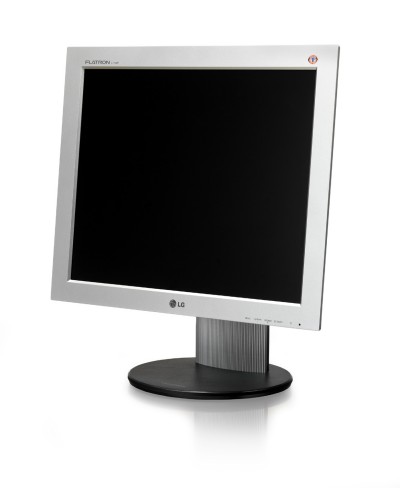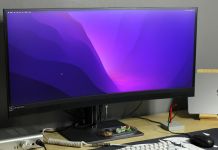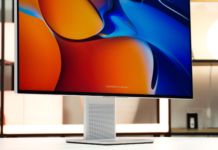LG 1730B is an LCD monitor with nice specifications at an attractive price. But can you really make a 17″ LCD monitor under these circumstances without the quality dropping? That’s what we aim to find out here.
Last time, we looked at a monitor from Sony that belonged to a different price category than the monitor we’ll be reviewing today. This monitor belongs to a more common segment, namely the average 17" category, where the market is experiencing a saturation of competitors. So how will this LG monitor stand up against the competition, and more importantly, should you buy it? This is what we aim to find out.
Moving on with the specifications on the next page.
|
|
Photo: LG Electronics
The following specifications have been taken from the manual and LG Electronics homepage.
|
Specifications
|
|
 |
|
|
LG Electronics L1730B
|
|
|
Size
|
17″ (337,9 x 270,3mm) |
| Pixel Pitch | 0,264(H)x 0,264(V)mm |
| Contrast ratio | 550:1 |
| Viewing angle | 160(H)/140(V) |
| Horisontal frequency | 30-83 kHz |
| Vertical frequency | 56-75 Hz |
| Brightness | 250 cd/m2 |
| Response time | 12 ms |
| Resolution | 1280 x 1024 |
| Colors | 16,2 million |
| Connections | D-Sub (Analog) & DVI-D (Digital) |
| Pivot | No |
| Adjustable foot | Yes |
| VESA standard | Yes, 100 x 100mm |
| Menu | OSD, 10 languages |
| Power consumption | < 40W (3W i standby) |
| PSU | Integrated, 90-264V |
| Speakers | No |
| Microphone | No |
| USB | No |
| Measurements (B x H x D) | 398 x 400,5 x 140 mm |
| Weight | 6,1 kg (13.3lbs.) |
| Warranty | 3 year |
There’s not too much to say about the specifications really. Nothing out of the ordinary, be it positive or negative.
Warranty
The three year warranty covers the functionality of the unit. More interesting, however, is the so-called pixel warranty. When shelling out several thousands for a monitor, one naturally expects it to be in working condition. LG has opted for the ISO 13406-2 standard for this monitor, which means some malfunctioning pixels can be expected. According to the ISO standard, there may be seven lit subpixels, seven dead subpixels, or any combination of the two, again no more than seven. Several major manufacturers follow this standard, which should be considered the bare minimum. With volumes and profits increasing over the years, I think the manufacturers should now move toward more demanding standards.
Standards
TCO-99, EPA, Energy Star, GOST, C-TICK, UL, cUL, SEMKO, FCC-B, CE, VCCI-2, ISO 13406-2, TUV-GS.
The following table shows what came in the package.
|
Content
|
| LCD-monitor |
| Power cable |
| HD15-HD15 video cable (VGA cable) |
| DVI-D video cable |
| Manual |
| CD-ROM (software, user guides etc.) |
| Warranty card |
| Monitor Driver Install Guide |
Installation
Install the drivers and connect the cables. That’s all the user has to do today. Nothing special, in other words. The bundled software consists of a disc with monitor drivers. Nothing more than what’s necessary.
Adjustments
The monitor offers several adjustments. The foot rotates around its own axis, and also lets you lower and raise the monitor. I particularly like this feature, one not found on many other monitors. Naturally, the screen can be set at different angles to suit your needs. The screen adjusts downwards as most others, and upwards slightly more. The only feature I miss is the pivot. However, one can wonder how many actually use it. One interesting thing about this monitor is that it can also be found without the height-adjustable foot. The product code is then L1730BSNT, and it offers everything else just as previously discussed. The pictures below show the monitor’s maximum height and angle adjustments.
 |
 |
 |
 |
The OSD is rather simple, I’d rather have seen a few more user profiles, even though I personally think one should calibrate the monitor for his personal needs. Some options aren’t available when using the DVI connection. They can bee seen in pictures 4,5, and 6 below.
 |
 |
 |
 |
 |
 |
Design is very personal, and as such, I’ll let the pictures below speak for themselves.
 |
 |
Design
LG created a very chic and clean design. It looks good without attracting attention. It’s not until I lok at the back that I raise and eye-brow. It has a different look, with some sort of ribbed aluminum look. It probably doesn’t cost more to make than a flat surface, but it’s different, and catches one’s attention. Certainly not uglier than than a more “regular” back-side. I’m sure this doesn’t make much of a difference since the monitor usually stands up against a wall anyway.
Quality
The monitor shows a little instability when you adjust it horizontally. The base, however feels solid, and there’s no risk it would fall over when accidentally bumped. To put this in perspective, if you had a sterring-wheel attached to your semi-robust table, and got wound-up in some racing game, the monitor would start to sway back-and forth. Of course, if the whole table’s shaking, I doubt you’re in any condition to notice the monitor moving around. Let’s move on to the buttons. They don’t infuse any sense of class, but they’re well set, and won’t be acidentally pushed. They probably won’t break or fall out either, there’s just a little too much “plastic” feel to them.
Functions
Just as for the Sony we tested earlier, this monitor is completely bare, no USB-ports, speakers or other gadgets. Both for good and for bad.
Connections
The monitor has digital and analog connectors. The tests are mainly conducted using the digital connection, if nothing else is indicated. The quality of the analog connection will be covered in a separate part of the test later on.
Hardware plays a minor role when testing monitors (except, perhaps the video card), but the software can make much more difference. Below you’ll see our sytem configuration.
|
Test system
|
|
|
Hardware
|
|
| Processor: |
AMD AthlonXP 2800+ Barton (2,087 GHz)
|
| CPU cooler: |
Zalman CNPS6000-CU
|
| Motherboard: |
Abit NF7-S v2.0
|
| RAM: |
1024 MB DDR400 CL2.5
|
| Video card : |
Radeon9600 PRO (128 MB, 400/300 MHz)
|
| Harddrive: |
RAID0: 2x 160 GB Seagate Barracuda 7200.7 SATA100 GB
Western Digial Caviar WD1000BB |
| Optical storage : |
NEC ND-2510A DVD+/-RW
|
| PSU: |
Antec True Power 380W
|
| Monitor: |
LG Electronics L1730B
|
|
Software
|
|
| Operating system: |
Windows XP Professional SP2
|
| Resolution: |
1280x1024x32bit, 60Hz
|
| Drivers: |
Catalyst 4.12
Detonator 61.77 DirectX 9.0c nForce Drivers v4.24 |
| Test program: |
Nokia Monitor Test v1.0a
|
| Games: |
Doom3
Quake III Arena Warhammer 40000: Dawn of War |
| Movies: |
Kill Bill: Volume 1 (DVD)
Terminator 2 (DVD) |
I’ve chosen three games that are demanding for dark, fast and detailed portions. The movies one colorful, one dark, and one older. Older remastered movies can seem too detailed and crisp on a sharp screen. More on this later.
The following tests will be as objective as possible. I’ll be using Nokia’s Monitor Test v1.0a, a widely used program for this kind of testing. It’s a rather simple program which tests different attributes such as brightness, conrast, convergence, colors, dead pixels etc.
Brightness and contrast
As expected, this monitor falls right into the mid-class range here. There’s nothing extraordinary about this monitor, but that doesn’t mean you won’t be satisfied either.
Escaping light
You could have also used the title ”blackness” since that’s what we mean. A LCD-monitor doesn’t have the same performance when displaying black, as would a CRT. It suffers from much more ”bleeding”, letting the back-light affect the darkness. An LCD monitor can’t live up to the blackness of a CRT in general, but can suffer from irregular escaping light on the other hand. The LG, however, leaves us satisfied, with an acceptable amount of bleeding.
Convergence
The high pixel pitch helps reduce convergence problems to almost nothing. In real-life situations, this problem doesn’t pose a greater impact on us every-day users.
Colors
The colors are evenly created all over the screen and has a nice balance. They are not very much alive, but more gray and dull and lose some intensity towards the edges, which is fairly common though but hard to notice.
Viewing angle
There’s no doubt that the specified viewing angles of 160 degrees horizontally and 140 vertically are correct. Everything is reproduced faithfully up until the specified angles, at which time the image degrades severely. LG stated the correct numbers here.
Analog vs. Digital
The majority of end-users will naturally be using DVI-connection, but there are times when the analog input could be desired. This input delivers excellent results, if you for some reason can’t use the digfital input, this one will definitely suffice. One can barely find any noise or distubances in the image. The analog input receives great marks.
Following are some subjective judgments of how I perceived the monitor in different situations. We’ll start by playing three games that will push the monitor to its maximum.
 |
Quake III Arena
|
|
One of the fastest games available today which puts the response to the test. Guaranteed high FPS with newer computers.
|
The game that still rank among the most used for testing finds its way even into this test. The monitor’s 12ms response time has no trouble at all keeping up with the game. But then, we never expected anything else, either.
 |
Warhammer 40K: Dawn of War
|
|
A strategy game that focuses on details and scaling. Dawn of War has plenty of details and shows a lot of information on the screen.
|
You could call this the opposite of Quake III, since we consider other aspects of the monitor. Here, we would prefer the computer to handle the monitor’s native resolution of 1280×1024. This will ensure all details are still there. However, this monitor does also handle scaling very well.
 |
Doom 3
|
|
Dark is probably the right word to describe this game with, which makes it perfect to test the monitor’s white/black properties with.
|
I’ve used Doom 3 in order to see how the details are reproduced in a FPS game at different resolutions. This also lets me see how the monitor handles the darkest game I could think of. The scaling at different resolutions works well, I can’t see any strange behavior. The dark areas are displayed surprisingly well. For a LCD, this isn’t bad at all. The darkest parts, however, still lack some detail.
Film
With a 17 inch monitor, one can watch movies and series if absolutely necessary, at least if they’re in the 4:3 format. The biggest problem with movies is when there are daker areas, with the blackness (or lack thereof) making it blaringly obvious that we’re talking about a LCD. At wide-screen formats, there’s a black bar above and underneath the image, making it all the more obvious.
I chose to watch a few parts of Kill Bill: Volume 1, since it is both a new high-quality movie, and has a lot of color, giving the monitor a little exercise.
The monitor handles both the detail and the coloring in an adequate way. Not much more to say here, really, it’s what should be expected from such a monitor in this day and age.
Finally, I chose to watch Terminator 2, one of my favorites. It’s an older movie that’s been restored to meet today’s higher demands. On a LCD, the image can easily become too detailed and crispy, making it look enhanced too much. I know I’m rather picky when it comes to detail, and I’ll try to take this into account when I make my final judgment.
The monitor handles very well in this test, I don’t really see a much crispier image than when comaring to watching it on a DVD player through a TV, although a slight difference can be noticed.
It’s hard to comment on a monitor like this. There are a lot of competitors in this price-range and size. It’s hard to say why you should or should not buy this particular monitor. I would say that monitors in this range have gained such a good response time, and display such a high-quality image, that they fulfill all the average users demands. Considering this, we have to look at other factors, such as build quality, availability, colors, brand-name preferences etc.
So, narrowing down to a more detailed perusal of the monitor, we’ll have to conclude that the best thing about this monitor is that it doesn’t have any major draw-backs. When all is said and done, the typical vertical monitor will look very similar to your normal computer monitor. Sure, it feels a little cheap, not very sturdy when being adjusted, but very cheap, or should I say great value. Fortunately, LG decided to concentrate on more important details, namely the image properties. I can’t really find anything negative about the image, just as I can’t find anything overly appealing either. Being in the mid-range class, this turns out to be a good score.
To sums things up, this monitor will give you a lot for your money, a base with relatively extensive adjustment settings, and a build-quality worth some praise. What you don’t get is USB ports, built-in speakers, or other features.
At the time of writing, this monitor can be found for less than €250, so if that’s your budget, and you value image over features, I’d definitely recommend the LG Electronics L1730B.
|
Pros Cons |
I’d like to thank Anton Lind for supplying the monitor for this review.
Photo: All images in this review are the property of Calle Drangel unless stated otherwise – www.djdreams.se





























Leave a Reply